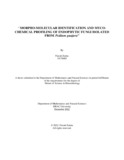Morpho-molecular identification and myco-chemical profiling of endophytic fungi isolated from Psidium Guajava
Abstract
Endophytic fungi reside inside healthy living plants without causing any disease or morphological
changes for the plant’s part or whole life cycle. It increases the plant defense system and produces
active secondary metabolites which have therapeutic abilities. These secondary metabolites have
the potential for drug development. Isolation and identification of endophytic fungi and screening
their associated secondary metabolites from the Psidium guajava plant grown in Bangladesh is a
recent and new approach. Guava or Psidium guajava is used as a fruit and medicinal plant. A total
of five endophytic fungi were isolated and purified from the leaf part – PgL1 and bark part – PgB1,
PgB2, PgB3, and PgB4 of the plant. All the isolated fungal strains were identified up to genus
level based on macroscopic and microscopic characteristics and up to species level based on
molecular characteristics- PgB1 as Phomopsis tersa, PgB2 as Diaporthe phaseolorum, PgB3 as
Colletotrichum siamense, PgB4 as Nemania primolutea, and PgL1 as Daldinia eschscholtzii. After
small-scale cultivation, the antimicrobial study was carried out for all fungi extracts by disc
diffusion method. They all exhibited poor to mild activity against all the tested Gram-negative and
Gram-positive bacterial strains. Only PgB4 showed good antibacterial activity. On the other hand,
PgB2 and PgB4 showed significant antifungal activity. The antioxidant test was done by the DPPH
scavenging method. Among the fungal extracts, PgB3 showed the highest antioxidant activity,
PgL1 showed significant antioxidant activity whereas PgB1, PgB2, and PgB4 showed moderate
antioxidant activity. Preliminary chemical screening of the fungal extracts by thin layer
chromatographic technique revealed the presence of various compounds such as flavonoids,
anthraquinones, couramins, isocoumarins, steroids, etc. The extract PgB3 was later purified by
solvent treatment with mixtures of n-Hexane, DCM, and methanol. Structural elucidation of the
isolated compound was done through their spectral data (NMR). The spectral data of the extract
suggests the compound was similar to sterol derivatives. The findings of this research indicate the
presence of a variety of endophytic fungi in the medicinal plant Guava and that it could be an ideal
target for the discovery of potentially bioactive compounds or lead structures for new drugs.

